Abstract
Several groups have reported that okadaic acid (OA) and some other tight-binding protein phosphatase inhibitors including microcystin-LR (MCLR), calyculin-A and tautomycin prevent each other from binding to protein phosphatase 2A (PP2A). In this paper, we have introduced an improved procedure for examining to what extent the affinity of an enzyme for a labelled tight-binding ligand is reduced by binding of an unlabelled tight-binding, ligand to the enzyme. Using this procedure, we have analysed the dose-dependent reduction of PP2A binding of [24-3H]OA by addition of OA, MCLR, calyculin-A and tautomycin. The results indicate that the binding of the unlabelled inhibitors to the PP2A molecule causes a dramatic (10(6)-10(8)-fold) increase in the dissociation constant associated with the interaction of [24-3H]OA and PP2A. This suggests that OA and the other inhibitors bind to PP2A in a mutually exclusive manner. The protein phosphatase inhibitors may share the same binding site on the PP2A molecule. We have also measured values of the dissociation constant (Ki) for the interaction of these toxins with protein phosphatase 1 (PP1). For MCLR and calyculin-A, the ratio of the Ki value obtained for PP1 to that for PP2A was in the range 4-9, whereas it was 0.01-0.02 for tautomycin. The value of tautomycin is considerably smaller than that (0.4) calculated from previously reported Ki values.
Full text
PDF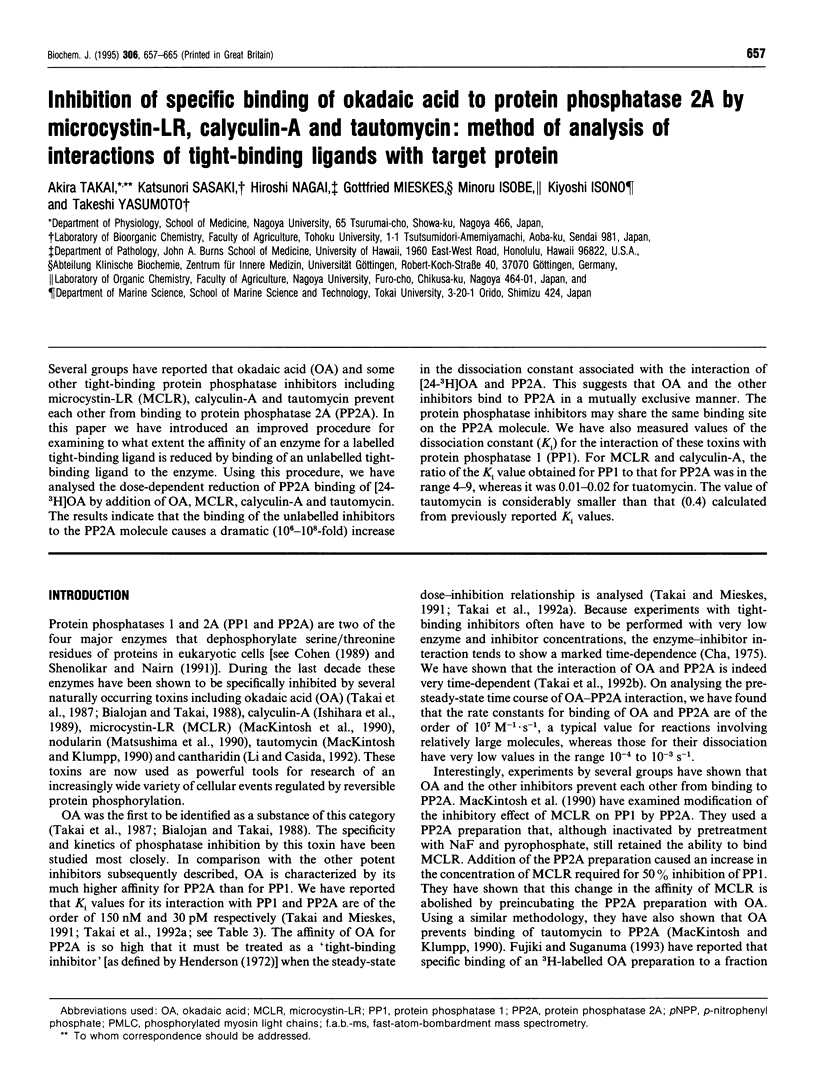



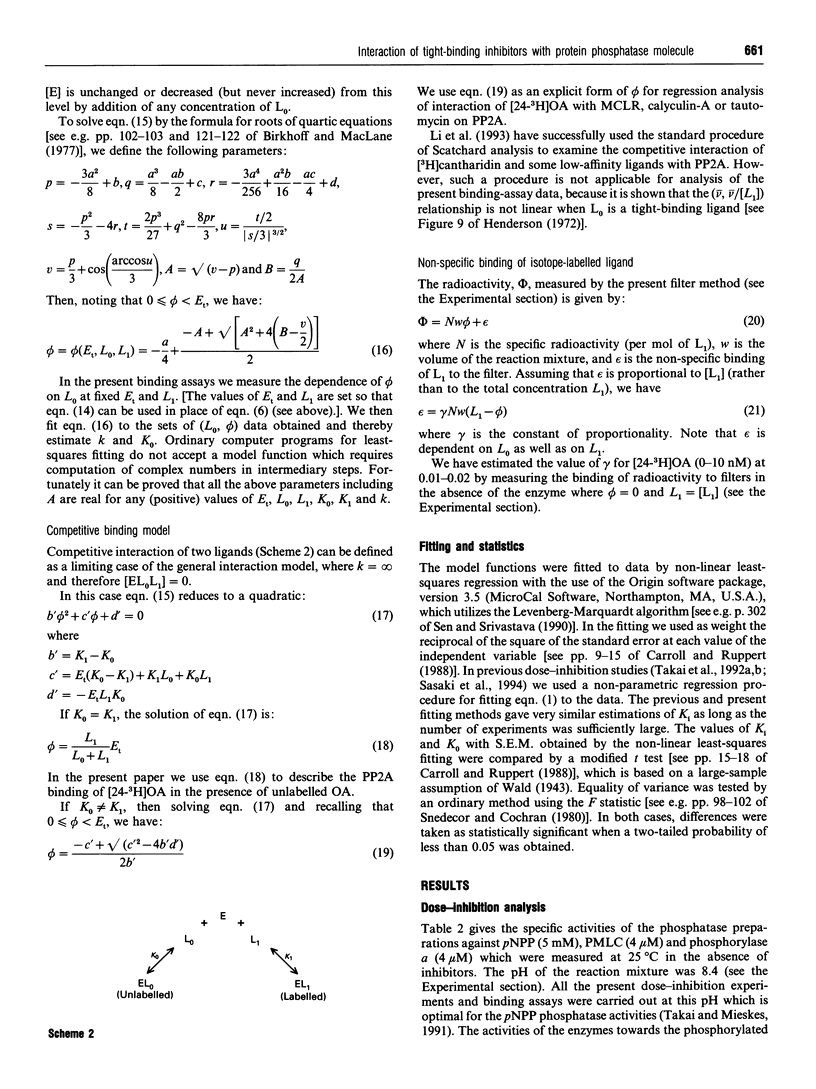
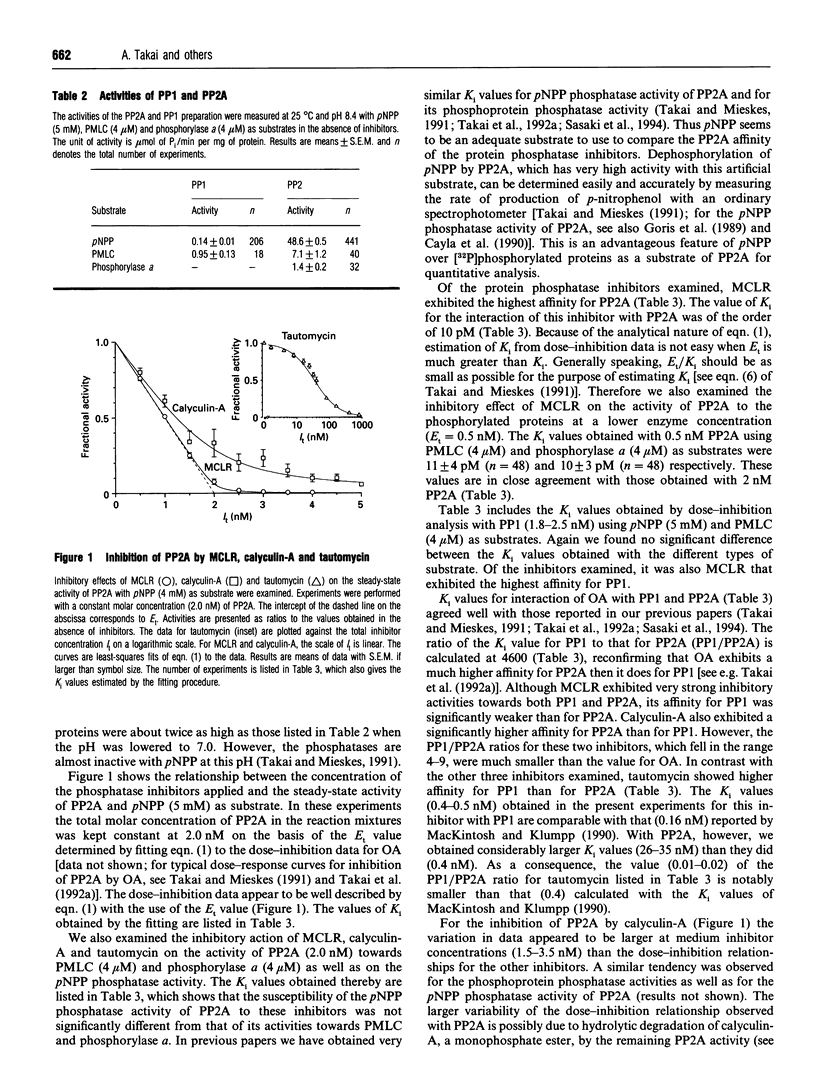
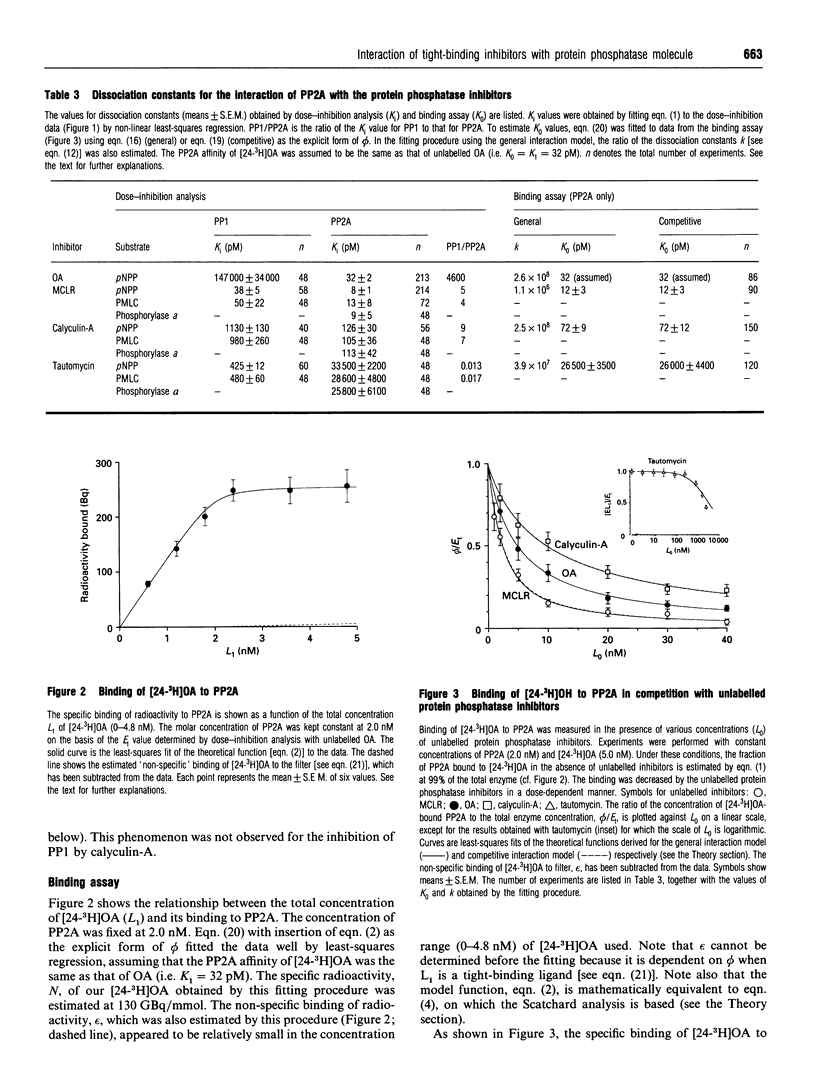
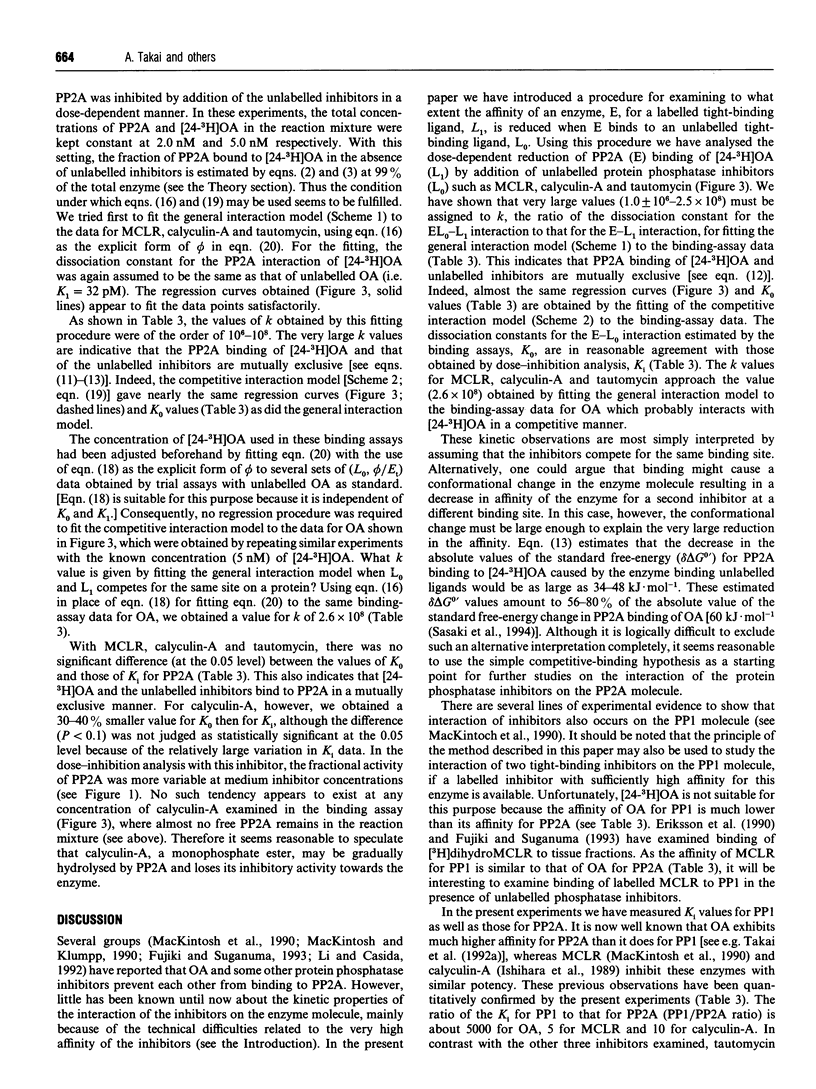

Selected References
These references are in PubMed. This may not be the complete list of references from this article.
- Antoniw J. F., Nimmo H. G., Yeaman S. J., Cohen P. Comparison of the substrate specificities of protein phosphatases involved in the regulation of glycogen metabolism in rabbit skeletal muscle. Biochem J. 1977 Feb 15;162(2):423–433. doi: 10.1042/bj1620423. [DOI] [PMC free article] [PubMed] [Google Scholar]
- Bialojan C., Takai A. Inhibitory effect of a marine-sponge toxin, okadaic acid, on protein phosphatases. Specificity and kinetics. Biochem J. 1988 Nov 15;256(1):283–290. doi: 10.1042/bj2560283. [DOI] [PMC free article] [PubMed] [Google Scholar]
- Cayla X., Goris J., Hermann J., Hendrix P., Ozon R., Merlevede W. Isolation and characterization of a tyrosyl phosphatase activator from rabbit skeletal muscle and Xenopus laevis oocytes. Biochemistry. 1990 Jan 23;29(3):658–667. doi: 10.1021/bi00455a010. [DOI] [PubMed] [Google Scholar]
- Cha S. Kinetic behavior at high enzyme concentrations. Magnitude of errors of Michelis-Menten and other approximations. J Biol Chem. 1970 Sep 25;245(18):4814–4818. [PubMed] [Google Scholar]
- Cha S. Tight-binding inhibitors-I. Kinetic behavior. Biochem Pharmacol. 1975 Dec 1;24(23):2177–2185. doi: 10.1016/0006-2952(75)90050-7. [DOI] [PubMed] [Google Scholar]
- Cheng X. C., Kihara T., Kusakabe H., Magae J., Kobayashi Y., Fang R. P., Ni Z. F., Shen Y. C., Ko K., Yamaguchi I. A new antibiotic, tautomycin. J Antibiot (Tokyo) 1987 Jun;40(6):907–909. doi: 10.7164/antibiotics.40.907. [DOI] [PubMed] [Google Scholar]
- Cheng X. C., Ubukata M., Isono K. The structure of tautomycin, a dialkylmaleic anhydride antibiotic. J Antibiot (Tokyo) 1990 Jul;43(7):809–819. doi: 10.7164/antibiotics.43.809. [DOI] [PubMed] [Google Scholar]
- Cohen P., Foulkes J. G., Holmes C. F., Nimmo G. A., Tonks N. K. Protein phosphatase inhibitor-1 and inhibitor-2 from rabbit skeletal muscle. Methods Enzymol. 1988;159:427–437. doi: 10.1016/0076-6879(88)59042-0. [DOI] [PubMed] [Google Scholar]
- Cohen P. The structure and regulation of protein phosphatases. Annu Rev Biochem. 1989;58:453–508. doi: 10.1146/annurev.bi.58.070189.002321. [DOI] [PubMed] [Google Scholar]
- Cummins P., Lambert S. J. Myosin transitions in the bovine and human heart. A developmental and anatomical study of heavy and light chain subunits in the atrium and ventricle. Circ Res. 1986 Jun;58(6):846–858. doi: 10.1161/01.res.58.6.846. [DOI] [PubMed] [Google Scholar]
- Eriksson J. E., Grönberg L., Nygård S., Slotte J. P., Meriluoto J. A. Hepatocellular uptake of 3H-dihydromicrocystin-LR, a cyclic peptide toxin. Biochim Biophys Acta. 1990 Jun 11;1025(1):60–66. doi: 10.1016/0005-2736(90)90190-y. [DOI] [PubMed] [Google Scholar]
- Fujiki H., Suganuma M. Tumor promotion by inhibitors of protein phosphatases 1 and 2A: the okadaic acid class of compounds. Adv Cancer Res. 1993;61:143–194. doi: 10.1016/s0065-230x(08)60958-6. [DOI] [PubMed] [Google Scholar]
- Goris J., Hermann J., Hendrix P., Ozon R., Merlevede W. Okadaic acid, a specific protein phosphatase inhibitor, induces maturation and MPF formation in Xenopus laevis oocytes. FEBS Lett. 1989 Mar 13;245(1-2):91–94. doi: 10.1016/0014-5793(89)80198-x. [DOI] [PubMed] [Google Scholar]
- Henderson P. J. A linear equation that describes the steady-state kinetics of enzymes and subcellular particles interacting with tightly bound inhibitors. Biochem J. 1972 Apr;127(2):321–333. doi: 10.1042/bj1270321. [DOI] [PMC free article] [PubMed] [Google Scholar]
- Ishihara H., Martin B. L., Brautigan D. L., Karaki H., Ozaki H., Kato Y., Fusetani N., Watabe S., Hashimoto K., Uemura D. Calyculin A and okadaic acid: inhibitors of protein phosphatase activity. Biochem Biophys Res Commun. 1989 Mar 31;159(3):871–877. doi: 10.1016/0006-291x(89)92189-x. [DOI] [PubMed] [Google Scholar]
- Klumpp S., Schultz J. E. Identification of a 42 kDa protein as a substrate of protein phosphatase 1 in cilia from Paramecium. FEBS Lett. 1991 Aug 19;288(1-2):60–64. doi: 10.1016/0014-5793(91)81003-q. [DOI] [PubMed] [Google Scholar]
- LOWRY O. H., ROSEBROUGH N. J., FARR A. L., RANDALL R. J. Protein measurement with the Folin phenol reagent. J Biol Chem. 1951 Nov;193(1):265–275. [PubMed] [Google Scholar]
- Li Y. M., Casida J. E. Cantharidin-binding protein: identification as protein phosphatase 2A. Proc Natl Acad Sci U S A. 1992 Dec 15;89(24):11867–11870. doi: 10.1073/pnas.89.24.11867. [DOI] [PMC free article] [PubMed] [Google Scholar]
- Li Y. M., Mackintosh C., Casida J. E. Protein phosphatase 2A and its [3H]cantharidin/[3H]endothall thioanhydride binding site. Inhibitor specificity of cantharidin and ATP analogues. Biochem Pharmacol. 1993 Oct 19;46(8):1435–1443. doi: 10.1016/0006-2952(93)90109-a. [DOI] [PubMed] [Google Scholar]
- MacKintosh C., Beattie K. A., Klumpp S., Cohen P., Codd G. A. Cyanobacterial microcystin-LR is a potent and specific inhibitor of protein phosphatases 1 and 2A from both mammals and higher plants. FEBS Lett. 1990 May 21;264(2):187–192. doi: 10.1016/0014-5793(90)80245-e. [DOI] [PubMed] [Google Scholar]
- MacKintosh C., Klumpp S. Tautomycin from the bacterium Streptomyces verticillatus. Another potent and specific inhibitor of protein phosphatases 1 and 2A. FEBS Lett. 1990 Dec 17;277(1-2):137–140. doi: 10.1016/0014-5793(90)80828-7. [DOI] [PubMed] [Google Scholar]
- Matsushima R., Yoshizawa S., Watanabe M. F., Harada K., Furusawa M., Carmichael W. W., Fujiki H. In vitro and in vivo effects of protein phosphatase inhibitors, microcystins and nodularin, on mouse skin and fibroblasts. Biochem Biophys Res Commun. 1990 Sep 14;171(2):867–874. doi: 10.1016/0006-291x(90)91226-i. [DOI] [PubMed] [Google Scholar]
- Ngai P. K., Carruthers C. A., Walsh M. P. Isolation of the native form of chicken gizzard myosin light-chain kinase. Biochem J. 1984 Mar 15;218(3):863–870. doi: 10.1042/bj2180863. [DOI] [PMC free article] [PubMed] [Google Scholar]
- Nimmo G. A., Cohen P. The regulation of glycogen metabolism. Phosphorylation of inhibitor-1 from rabbit skeletal muscle, and its interaction with protein phosphatases-III and -II. Eur J Biochem. 1978 Jun 15;87(2):353–365. doi: 10.1111/j.1432-1033.1978.tb12384.x. [DOI] [PubMed] [Google Scholar]
- Sasaki K., Murata M., Yasumoto T., Mieskes G., Takai A. Affinity of okadaic acid to type-1 and type-2A protein phosphatases is markedly reduced by oxidation of its 27-hydroxyl group. Biochem J. 1994 Mar 1;298(Pt 2):259–262. doi: 10.1042/bj2980259. [DOI] [PMC free article] [PubMed] [Google Scholar]
- Shenolikar S., Nairn A. C. Protein phosphatases: recent progress. Adv Second Messenger Phosphoprotein Res. 1991;23:1–121. [PubMed] [Google Scholar]
- Takai A., Bialojan C., Troschka M., Rüegg J. C. Smooth muscle myosin phosphatase inhibition and force enhancement by black sponge toxin. FEBS Lett. 1987 Jun 8;217(1):81–84. doi: 10.1016/0014-5793(87)81247-4. [DOI] [PubMed] [Google Scholar]
- Takai A., Mieskes G. Inhibitory effect of okadaic acid on the p-nitrophenyl phosphate phosphatase activity of protein phosphatases. Biochem J. 1991 Apr 1;275(Pt 1):233–239. doi: 10.1042/bj2750233. [DOI] [PMC free article] [PubMed] [Google Scholar]
- Takai A., Murata M., Torigoe K., Isobe M., Mieskes G., Yasumoto T. Inhibitory effect of okadaic acid derivatives on protein phosphatases. A study on structure-affinity relationship. Biochem J. 1992 Jun 1;284(Pt 2):539–544. doi: 10.1042/bj2840539. [DOI] [PMC free article] [PubMed] [Google Scholar]
- Takai A., Ohno Y., Yasumoto T., Mieskes G. Estimation of the rate constants associated with the inhibitory effect of okadaic acid on type 2A protein phosphatase by time-course analysis. Biochem J. 1992 Oct 1;287(Pt 1):101–106. doi: 10.1042/bj2870101. [DOI] [PMC free article] [PubMed] [Google Scholar]
- Tung H. Y., Resink T. J., Hemmings B. A., Shenolikar S., Cohen P. The catalytic subunits of protein phosphatase-1 and protein phosphatase 2A are distinct gene products. Eur J Biochem. 1984 Feb 1;138(3):635–641. doi: 10.1111/j.1432-1033.1984.tb07962.x. [DOI] [PubMed] [Google Scholar]


